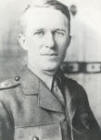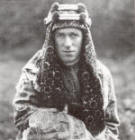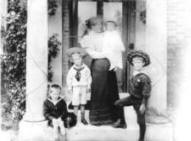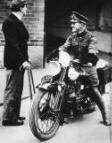|



Thomas Edward (Ned) Lawrence
1888-1935
T.E. Lawrence was gay. He was also
courageous to a spectacular degree. He became famously known as
Lawrence of
Arabia.
Apparently, Lawrence's mother was quite the character.
Lawrence likened the struggle he fought
as a child for spiritual independence from his mother to defending a
medieval tower that is under constant siege and attack.
This is an excerpt
from Lawrence: The Uncrowned King of Arabia
by Michael Asher:
His need to protect his spiritual
independence would emerge throughout his
life in an obsession with images of siege
warfare, of attack and defence: 'I think I'm
afraid of letting her get, ever so little,
inside the circle of my integrity,' he wrote
of his mother, 'and she is always hammering
and sapping to come in . . . I always felt
she was laying siege to me and would conquer
if I left a chink unguarded.'
This image of his self as a circle or
citadel of integrity recurs repeatedly. Even
as a boy, he would tell his brothers an
endless tale about the defence of a tower by
warlike dolls against hordes of barbarous
enemies, and the motif appears again in the
study of crusader castles in Britain, France
and Syria to which he devoted much of his
youth, and which led to the thesis he
presented for his degree.
Here's a picture of Ned (sitting),
his brother Will, mother Sarah, baby Frank and brother Bob. The
youngest, Arnie, wasn't born yet.

T.E. Lawrence's family
In 1915, Will and Frank got
themselves killed while fighting
 WWI in France.
WWI in France.
 Check event in the WWI Timeline.
Check event in the WWI Timeline.
Pain was the one thing Lawrence
was abnormally frightened of. How did he cope? By exposing himself purposely
to physically painful situations. This coping mechanism culminated
later in becoming a full-blown masochist.
Lawrence was very attracted to / in love
with at least
twice: first with Dahoum (see photo below) in 1911 and after the war
in 1922 with a guy in the army named R.A.M. Guy. I still bet farm
and family that they made the name up, I mean what are the
odds.
 EK received mail from a person who says RAM Guy was their relative. R.A.M.
stands for Robert Austen Marston, as Marston was Guy's mother's
maiden name, so the email explains. Looks like I lost farm and
family.
EK received mail from a person who says RAM Guy was their relative. R.A.M.
stands for Robert Austen Marston, as Marston was Guy's mother's
maiden name, so the email explains. Looks like I lost farm and
family.

DAHOUM
Lawrence of Arabia � Fact and Fiction
Lawrence was notoriously making things up as he went. Desert
explorer Michael Asher found this out the hard way when he attempted
to reconstruct Lawrence's camel-trek through the Sinai Desert.
In his work Seven
Pillars of Wisdom, Lawrence claimed that this trip took him only
49 hours. Asher and his team struggled hard and nearly lost a man,
but couldn't pull it off. Asher later came across Lawrence's Skeleton Diaries
and realized that Lawrence - as so many times before - had not been telling the truth.
Like the man already? Wait until you
hear how he accidentally shot the camel he was riding (many a man's favorite
story).
But Lawrence accomplished more than that.
In WWI, the British fought the Turks
(Germany's ally) in the Middle East. The Brits could use some help
and thought of the Arabs as potential allies. The Arabs felt
inclined to fight the Turks, having been under Turkish
rule for over 500 years.
An Arab Revolt against the
Turks would certainly help the British cause. But how to instigate
the Arabs against the Turks?
Advisers in Arabic affairs were rare
but desperately needed
by the British in order to negotiate with the Arabs. And this is where Lawrence entered the
picture. He loved all things Arabia and spoke the language fairly well.
Backed by British gold, Lawrence was
appointed liaison officer and became an indispensable link between
Brits and Arabs. He rallied the Arab tribes, lead a guerrilla
force behind Turkish lines, and
 destroyed bridges and railways. The Arab
Revolt was successful and the longtime Turkish rule over Arabian territory
came to an end.
destroyed bridges and railways. The Arab
Revolt was successful and the longtime Turkish rule over Arabian territory
came to an end.
In order to
get Arab support for the Revolt, Lawrence promised the Arabs territory which he knew the British would
never hand over. (See Sykes-Picot Agreement of 1916) The Arabs felt sold down the river.
And rightly so.
Lawrence stated that he himself felt lousy about this.
Nevertheless, Lawrence became a legend. He published
his version of his adventures in Seven Pillars of Wisdom.
After WWI, Lawrence re-enlisted first
in the Royal Air Force under the name John Hume Ross and later in
the Royal Tank Corps as T.E. Shaw. He later served in India.
Lawrence retired from military services
in 1935. That same year he had a motorcycle accident and died 6 days
after the accident. The picture below is
 Lawrence's grave in Moreton, Dorset. Lawrence's grave in Moreton, Dorset.

T.E. Lawrence Grave
I read Lawrence's biography by Michael Asher
and liked it. Asher's love for the subject seems to go hand in hand
with objectivity. He is not afraid of talking about the legend
Lawrence of Arabia in human terms. Asher is a desert
explorer and ex-military man himself.
Asher got a lot of heat for this book.
Jeremy Wilson, authorized T.E. Lawrence
biographer, wasn't too thrilled about Asher's work.
What else?
Lawrence loved riding his motorcycle
fast. Very fast. Asher said he was a speed addict. That is racing
fast, not amphetamines.

T.E. Lawrence
Motorcycle
More History
|